Hello everybody! The good news is – my camera (and therefore blog) is back in action! The bad news is – I’m heading overseas again for two weeks this weekend. Well, this should keep you busy.
I’ve had quite a kombucha obsession for a while, particularly GT Dave’s Gingerade Kombucha. But my pocketbook was begging me to quit the habit, as those little 16-oz bottle run about $4 a pop.
Enter homebrewing.
A friend gave me a SCOBY, the disc of bacteria and yeast necessary to ferment sweetened black tea into kombucha. If you don’t know anybody that brews, you can order them online. They are really good at making babies so it should be a one time purchase. Consider yourself warned though: SCOBYs are not pretty.
The actual process is really simple. This source is a really good guide, as is this one. I recommend reading through instructions before you start. Here are my simplified tips in summary of what I’ve learned:
- Don’t use metal utensils with the SCOBY or kombucha
- Don’t wash your hands with antibacterial soap before you handle the SCOBY. Rinse them well with water and pour vinegar over your hands before you touch it
- It works best with plain black tea, nothing flavored like earl grey.
- It works best with plain, old-fashioned white sugar. Maple, honey, turbinado sugar, agave, etc. won’t work because they cause the wrong pH for fermenting. This is the only use for white sugar that I recommend! 🙂
- You can use tap water but it works best with purified, filtered water without the added fluoride and other minerals.
- Watch for signs of cross contamination like mold, or damage to the SCOBY like black spots.
You will need:
- Large glass container
- Clean kitchen towl
- Large rubberband
- Black tea bags
- Purified water
- White sugar
- SCOBY
- Starter liquid: 2 cups plain commercial or homemade kombucha from a previous batch
- glass bottles or jars for second fermenting
- flavors (optional)
The process:
1. Make sweet tea! Combine the water and sugar, and then add tea bags when it reaches a boil. I have a 1 gallon container so I made 1.5 gallons of water, used 1.5 cups white sugar, and 12 teabags. If you have a smaller container you can use these amounts: 1 quart water, 2 teabags, and 1/4 cup sugar.
2. Let it steep a long time. I did 10 minutes. You want it a lot stronger than you would if you were drinking it.
3. Let the tea cool completely. If it’s too warm, it can kill or damage the SCOBY.
4. To your clean glass container, add the starter liquid, cooled sweet tea, and scoby.
5. Cover with the clean towel, and rubberband it. The SCOBY may float, sink, or hang out somewhere in the middle. All are normal.
6. Allow it to sit and ferment for 1-4 weeks. A “baby” SCOBY will start to form over the top surface. At 1 week, begin tasting it periodically. I used a straw – slid it down past the baby forming, covered the top opening with my finger, and pulled some up like a pipet.
7. When you like how it tastes, it’s time for the second fermentation – where you flavor the kombucha and/or allow it to carbonate. I used small mason jars but I’ve heard flip-top bottles are much better. The second fermentation lasts 5-14 days. It’s ready when you like the flavor. Here are my recipes for the three flavors:
Lavender Chamomile
For every 8 oz of kombucha, add 1/4 tsp chamomile flowers and 1/8 tsp lavender buds.
Apple Spice
For every 8 oz of kombucha, add 2 slices of apple, 1/2 inch thick, and 1/4 tsp whole mullling spices (blend of cloves, cinnamon, nutmeg)
Lemongrass Ginger
For every 8 oz of kombucha, add 2 pieces of whole lemongrass (each about 2 inches long) and 1-2 tsp chopped fresh ginger
I actually tested out a whole bunch of other flavors -ginger, lemon ginger, lemon chamomile, jasmine, pomegranate, pomegranate ginger, and plain.
After the second fermentation, store the kombucha in the fridge so the fermentation slows down. You can store the SCOBYs until your next batch. I made a SCOBY hotel. 🙂
I would love to hear your experiences and ideas for brewing kombucha!

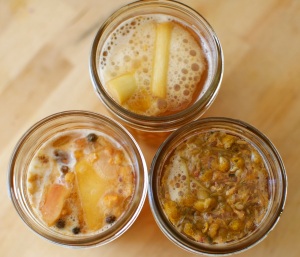
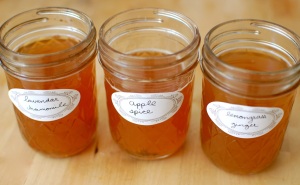
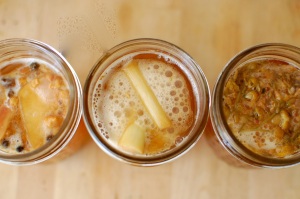
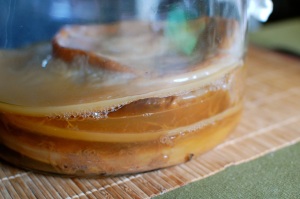
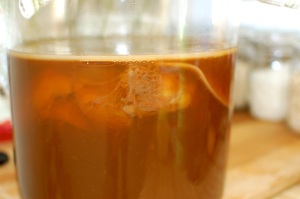
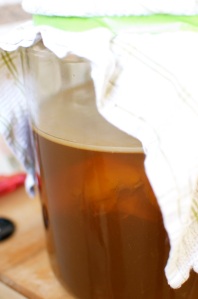
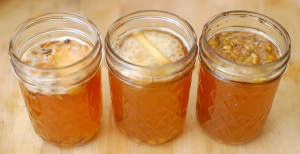

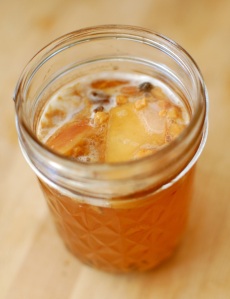
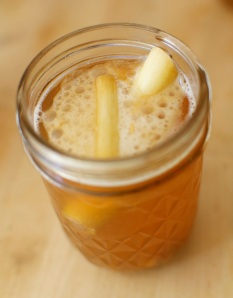
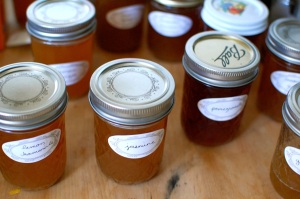
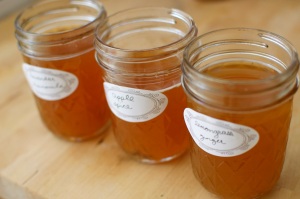
All those flavors sound so amazing. I’ve never tried kombucha yet…sounds very interesting!
Aw, thanks! You should definitely give kombucha a try…it tastes like some cross between apple juice, apple cider vinegar, and a light beer, maybe. It’s a little bit of an acquired taste but you’ll probably love it. It’s super good for the digestion with all those beneficial bacteria too! Thanks for stopping by my little corner of the web. 🙂
i looooooooove kombucha!!!!! so cool you brew it at home!! i’m eager to try that one day very soon!
You should totally try it Audrey! I’ve been intimidated by the process but it’s sooo much simpler than it seems! I have lots and lots of Food and Foto to catch up on. 🙂
me too! but that makes me feel better. 🙂 was yours nice and sparkly or more of the vinegar-y type?! i love the bubbles and burps best about kombucha 😉 missed you, good to have you back!
That’s one of the nice things about making your own – you have total control over the flavor! If you like it really strong, tangy, vinegary – let it ferment for longer. Lighter, sweeter – shorter fermentation! The bubbly comes during the second fermentation. Mine wasn’t that carbonated because I used mason jars, which aren’t technically airtight. To get a good bubble going on, you really have to use a flip-top jar or an old wine bottle with a new cork. Give it a try! It more than pays for itself in 1 batch!
wow becca thanks SO MUCH for your recommendation!!! i’m so eager and way less intimidated to try it now!!! have you ever tried making a batch from a previous batch… essentially creating your own scoby?! i’ve heard of people doing that but wasn’t sure of the results… talk more soon, i’ll respond to your comment 🙂
Yay! I’m excited that you’re excited about it. Yeah, I think making your own scoby will work ok, but i think it will take a loooong time to grow, especially if you use commercial kombucha. You can have one of my scobys! I have, um, 5 right now. 🙂
omg, that sounds awesome! i can trade you for something amazing when we meet for dinner one of these nights soon 🙂